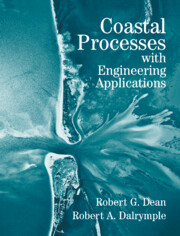Book contents
- Frontmatter
- Contents
- Preface
- Acknowledgments
- PART ONE INTRODUCTION TO COASTAL PROCESSES
- PART TWO HYDRODYNAMICS OF THE COASTAL ZONE
- PART THREE COASTAL RESPONSE
- PART FOUR SHORELINE MODIFICATION AND ANALYSIS
- 11 Beach Fill and Soft Engineering Structures
- 12 Hard Engineering Structures
- 13 Tidal Inlets
- 14 Shoreline Management
- Author Index
- Subject Index
13 - Tidal Inlets
Published online by Cambridge University Press: 29 May 2010
- Frontmatter
- Contents
- Preface
- Acknowledgments
- PART ONE INTRODUCTION TO COASTAL PROCESSES
- PART TWO HYDRODYNAMICS OF THE COASTAL ZONE
- PART THREE COASTAL RESPONSE
- PART FOUR SHORELINE MODIFICATION AND ANALYSIS
- 11 Beach Fill and Soft Engineering Structures
- 12 Hard Engineering Structures
- 13 Tidal Inlets
- 14 Shoreline Management
- Author Index
- Subject Index
Summary
Inlets are created through barrier islands either naturally by storms or water-courses, or they are man-made. On some coastlines, the spacing between inlets can be quite large, creating public pressure for additional navigational access. This is the case at Santa Rosa Island on the Gulf Coast of Florida. This island extends 80 km from Destin Pass at the east to Pensacola Bay entrance at its western terminus. Both nature and humans have tried to establish a new inlet about midway along the island length at Navarre Beach, Florida, but to no avail. The result was always the same: after several months, the inlet would migrate, shoal, and eventually be sealed off by the waves (see Figure 13.1). In the 1970s, we conducted a study to try to determine the cause of the very brief life of this inlet. Our conclusion was that the tides in this area were insufficient to maintain an inlet. The tides are predominantly diurnal and during certain phases of their cycle have quite small tide ranges (only 10 cm or so). It is during these periods that the scouring capability of the tidal currents is greatly diminished, leaving the inlet at the depositional mercy of the waves. If a storm occurs, sand is deposited in the inlet, contributing to its hydraulic inefficiency and eventual demise. How then do the adjacent inlets on Santa Rosa Sound survive?
- Type
- Chapter
- Information
- Coastal Processes with Engineering Applications , pp. 413 - 451Publisher: Cambridge University PressPrint publication year: 2001



